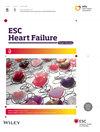HEART Camp Connect—Promoting adherence to exercise in adults with heart failure with preserved ejection fraction
Abstract
Aims
Most adults with stable heart failure are safe to exercise at a moderate intensity for 150 min/week. Regular participation in exercise may improve outcomes in adults with heart failure with preserved ejection fraction (HFpEF). Few adults with HFpEF initiate and sustain long-term exercise. To promote exercise adherence in adults with HFpEF, we developed the Heart Failure Exercise and Resistance Training (HEART) Camp Connect intervention that is tested in this clinical trial. This trial tests our central hypothesis that theory-informed coaching strategies delivered virtually will promote long-term adherence to exercise in adults with HFpEF and drive clinically meaningful, and cost-effective improvements in physiological and patient-reported outcomes. Our aims are to (a) evaluate the effects of virtual and in-person exercise and coaching on long-term adherence, (b) determine a benchmark of minutes of moderate intensity exercise associated with health status as related to key biobehavioural outcomes, (c) examine behaviour change theory-defined constructs as mediators of exercise adherence and (d) evaluate intervention costs.
Methods
This 18 month, three-group, repeated measures randomized controlled trial is enrolling 300 adults with HFpEF. Participants are randomized to enhanced usual care (EUC), virtual coaching, or in-person coaching. Our intervention applies coaching strategies, informed by behaviour change theories, in one-on-one and group settings weekly for 12 months. Our objective is to compare the effects of each delivery method to the other and EUC on exercise adherence (defined as ≥ 120 min of moderate intensity exercise/week) at 12 months (primary endpoint) and 18 months (sustainability endpoint). Secondary outcomes include minutes of moderate intensity exercise needed to drive minimal clinically important differences in health status, biomarkers, patient-reported symptoms and cost. Behaviour change theory-defined constructs (e.g., self-efficacy and outcome expectations) will be tested as mediators of exercise adherence.
Results
We expect that virtual coaching is equally as efficacious and more cost effective at promoting exercise adherence as in-person coaching. Effects on exercise adherence may be mediated by theory-defined constructs. We also expect to identify a threshold for minutes of moderate intensity exercise to potentially serve as an adherence benchmark in adults with HFpEF, one that may differ from the 120 min of exercise in our current definition.
Conclusions
These findings could shift the paradigm of exercise coaching in HF towards virtual delivery and increase the generalizability and reach of exercise training. This is especially important for adults with HFpEF as they are excluded from Medicare reimbursement for traditional cardiopulmonary rehabilitation.


 求助内容:
求助内容: 应助结果提醒方式:
应助结果提醒方式:


